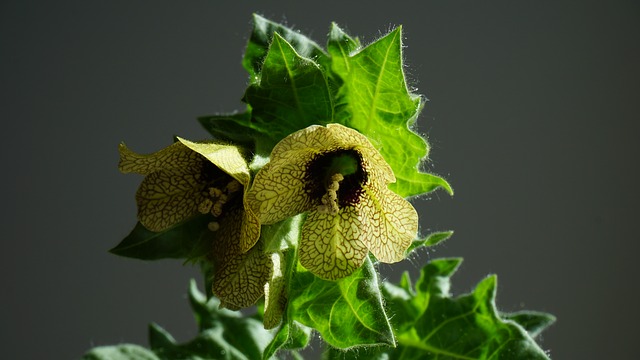 |  |  |  |  |
 |  |
A biennial plant covered with a velvety coating. The root is vertical, little branched, 2-3 cm in diameter, soft, with an expanded rhizome neck. The leaves of the plant have a very broad morphology: they are dark green from above, lighter from below, the lower root leaves are in a rosette, elongated ovate, notched-oval-skeleted, usually die during flowering. Stem leaves, sessile, ovate-lanceolate, notched-flattened, 3-25cm long, 3-10cm wide. The stem grows 20-60 cm long and more, cylindrical, covered with hairs. The flowers are large, 2.5-4 cm in diameter, slightly zygomorphic, sessile, placed on the upper leaves. Calyx grown, with a deep slit. Petals connate, funnel-shaped, with a dirty yellow shade and dark purple reticulation and the middle of the flower.
The fruit is a box, closed with an opening cap. The seeds are small (up to 1.5 mm long), brown-gray, round or slightly elongated and flattened.
Flowers from June to July, seeds ripen in August or September.
For medicinal purposes, the leaves and leaf-covered stems are harvested from annual plants that are harvested in autumn when leaves have developed at the rhizome; the leaves of biennial plants are harvested during the flowering period, but when the seeds are ripe, the whole plant is harvested.
Dry in a well-ventilated and shaded place, spread on sieves 1-2 cm thick, periodically stirring them, or in dryers at a temperature not exceeding 60C. Before drying, the plant is usually crushed.
Henbane
is a highly poisonous plant that can cause severe poisoning, often with a fatal outcome. Children are more often poisoned. Therefore, you need to be very, very careful with this plant if it is harvested. After collection and any contact with it, it is necessary to wash your hands thoroughly. Because you can also get poisoned by parts of the plant that remain on your hands, for example by accidentally rubbing your eyes.
All parts of the plant contain alkaloids, mainly hyoscyamine, atropine, scopolamine: in roots (up to 0.18%), leaves (up to 0.10%), stems (about 0.02%), seeds (up to 0.10%). The maximum dose of alkaloids in the leaves has been found at the beginning of the flowering period.
Natural substances of glycosides have also been found in
Henbane
: hyposcipicin, hyoscyrin, hyoscyresin. The seeds of the plant contain up to 34% oil fat, usually light yellow in color. The composition of sheep fat includes oleic acid up to 22.4%, linoleic acid up to 71.3% and unsaturated acids up to 6.3%.
Medicinal significance
Preparations of
Henbane
are used as antispasmodics and analgesics, as well as sedatives in psychiatric practice and surgery, before a person is prepared for anesthesia.
The effect of the preparations of
Henbane
is determined by the alkaloids contained in it - hyoscyamine, atropine, scopolamine, which have anticholinergic properties that create a therapeutic effect. The atropine contained in the
Henbane
is used in the practice of eye treatment, as a remedy for myrrh. Atropine has a pronounced effect on saliva secretion, digestive and sweat glands, as well as on heart rhythm, intestinal smooth muscles, bronchial muscles. Atropine also causes pupil dilation.
An important medicinal property of
Henbane
is relaxation of bronchial musculature and reduction of secretion of bronchial glands, as well as anesthetic effect, together with chloroform in case of rheumatism and neuralgic diseases.
The possibilities of
Henbane
have been known to people for a long time, but due to the plant's toxicity, this plant is practically not used in folk medicine. There are cases when folk medicine uses an alcohol infusion of
Henbane
oil, which is used to externally treat gout-affected areas, relieve rheumatic and neuralgic pains, treat boils and carbuncles in the initial stage, rub in colds, coughs, pleurisy and other problems.
Henbane
seed oil is applied alone to massage muscles and bruises. Very cautiously, decoctions of the leaves of
Henbane
are used to treat the stomach, to prevent asthma, to reduce liver and intestinal colic, to get rid of diarrhea, bladder spasms and toothache. However, it is recommended to choose other plants for this purpose and not to start the treatment with
Henbane
on your own.
